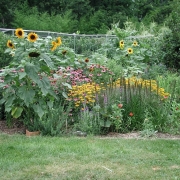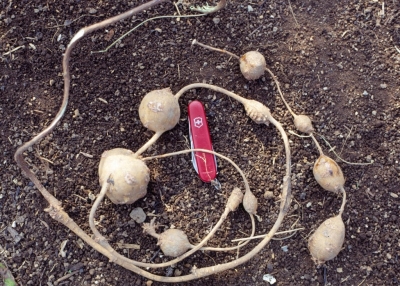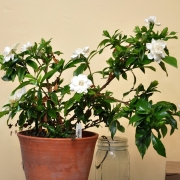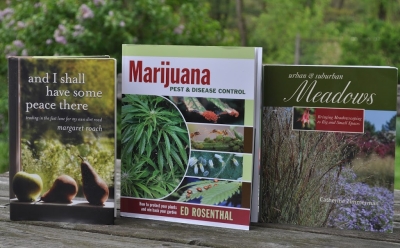FLOWER BED MAKEOVER
A recent visit to the garden of Margaret Roach (http://awaytogarden.com/) inspired me to makeover a flower bed. Margaret’s garden is all ornamental, a sometimes lively, sometimes subdued interplay of plant shapes with leaf textures and spots of color. My garden is mostly for eating, although I balance that functionality with rustic arbors, shrubbery (some of it edible and ornamental), and interplay of sight lines. And I do have a couple of flower beds.
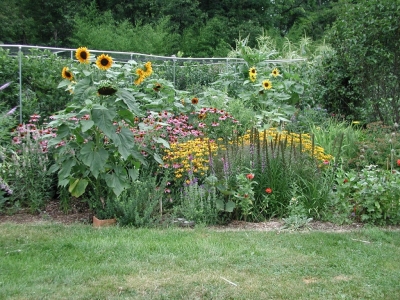 |
| My flower bed 10 years ago. |
Looking at photos of one of my beds from years past highlighted for me just how much in need it was for a makeover.
The attack began on ‘Miss Kim’ lilac. She was supposed to be a dwarf lilac (a different species, Syringa patula, than the common lilac, S. vulgaris), and I suppose she is a dwarf, comparatively speaking. But she’d grown too big and too dense for the flower bed so I did an extensive renovation, cutting to the ground a few of the oldest stems, thinning out some of the youngest ones so that those that remain would have room to develop, and then shortening or removing any other stem that was creating congestion or was in my way. The new ‘Miss Kim’ took some getting used to, like a new haircut, but now I’m pleased and other plants in the bed have more light and space.
I was more brutal with the butterfly bush. Butterfly bush is one of my favorite shrubs but this one takes over the bed each summer. And I’d just received a sample plant of a new series — the Flutterby series — of butterfly bushes, notable for their small stature and long bloom period. The humongous root system of the old butterfly bush was no match for a chain and the Kubota tractor. Into the waiting hole went a Flutterby.
Next, I took a shovel to the Siberian irises, wonderful plants with pleasant, blue blossoms and spiky, green foliage — until the plants become overcrowded, at which point they become mostly just foliage. The plants need dividing every 3 years or so to prevent overcrowding. Dividing them was actually the hardest job because of the tough root systems. I probably removed about half the plants.
Finally, more herbaceous interlopers — which included a lot of garlic, jewelweed, and errant irises and daffodils — got cleaned up. What’s left is a clean palette, some patches of bare soil ready for some new plants. Thus far: an orange osteospermum off to one side, and deep pink rose campion with purple-pink coneflower on the other side.
—————————————————–
Digging in the flower bed unearthed some golfball-sized tubers connected together like a chain of beads. I immediately recognized them as tubers of Apios americana, sometimes called Indian potato or groundnut (not to be confused with that other groundnut, the peanut). How did I recognize them so quickly? Because I planted groundnuts about 25 years ago!
Groundnuts should be more famous; they are the unsung heroes of Thanksgiving. The Wampanoaga Indians introduced the Pilgrims to this plant, and the Pilgrims’ diet during one of those first winters was supplemented by an Indian cache of groundnuts and corn discovered by Miles Standish. The Pilgrims soon coveted this food for themselves, to the extent of issuing an edict in 1654 ordering that: “if an Indian dug Groundnuts on English land, he was to be set in stocks, and for a second offense, be whipped.”
Native Americans didn’t really cultivate groundnuts, but merely coaxed them along where they grew naturally. Modern Americans became interested in domesticating groundnuts a few decades ago. Hence my groundnuts, sent to me by one of those modern Americans.
Groundnut can be weedy, spreading all over the place via those tuberous chains. I’ve been half-heartedly weeding groundnuts out of my flower bed for 23 years, looking in vain for tubers each time I weeded. Evidently, I didn’t dig deeply enough — until this flower bed makeover.
—————————————————–
 |
| Clematis ‘Piilu’ |
The flower bed is also home to a couple of clematis vines that climb up 5-foot-high wire towers, and beyond. No clematis vines will be touched by a shovel for the makeover, especially since this has been such a spectacular year for those two and other clematis vines I grow. Why this year? Who knows? Clematis are generally winter hardy and not particularly at the beck and call of the weather.
My favorite clematis, named Piilu, arrived here a couple of years ago from Klehm’s Song Sparrow Farm and Nursery (http://www.songsparrow.com/). Piilu grows only about 5 feet high to make a very densely flowering column (with support) of flowers. The flowers have pale lavender petals whose intensity deepens towards their bases, at which also sits a dense bottlebrush of creamy white stamens. The plant blooms all season, with later flowers, borne on new stems, having double rows of petals.
—————————————————–

